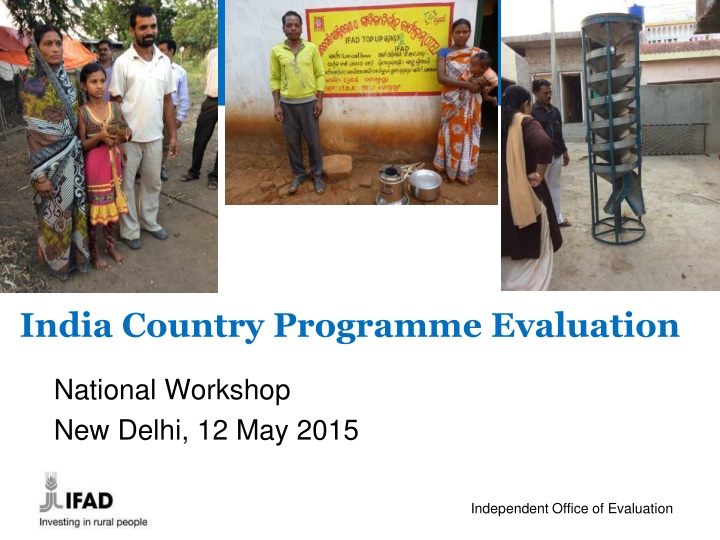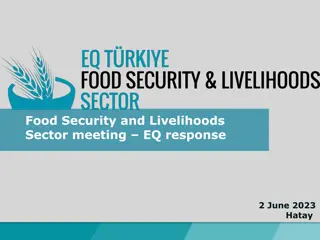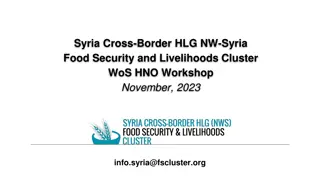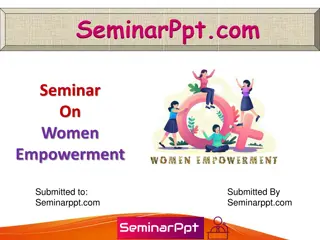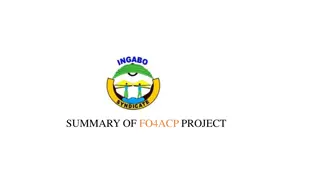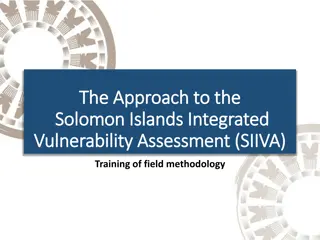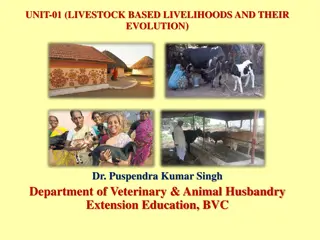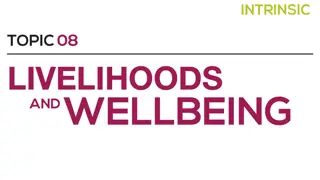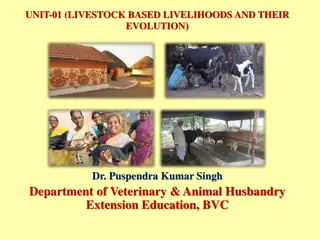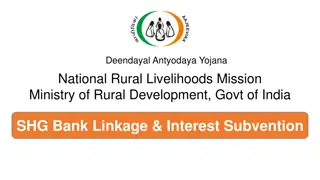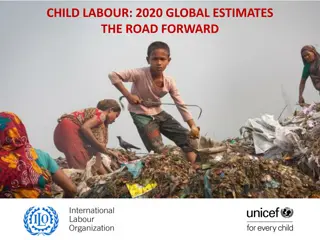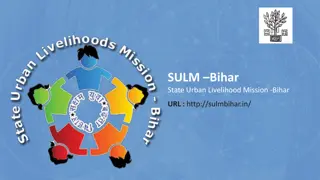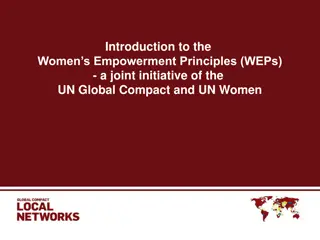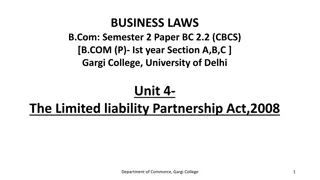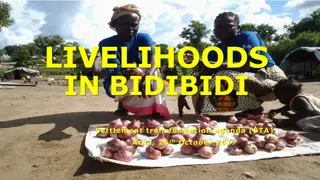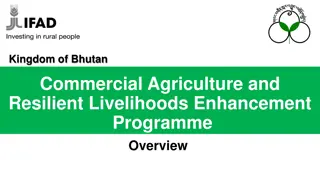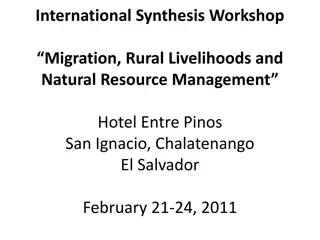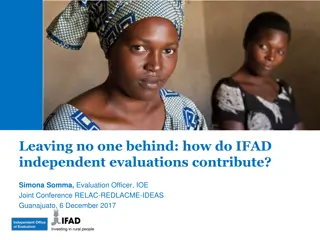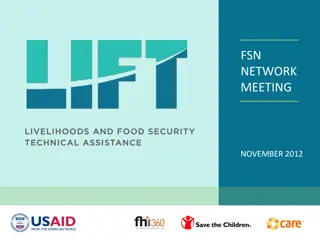IFAD-India Partnership: Enhancing Livelihoods and Empowerment
The IFAD-India cooperation has been instrumental in supporting rural development projects since 1979, focusing on empowering tribal communities, smallholder farmers, women, and youth. The evaluation of the country programme highlights the strategic objectives and innovative approaches implemented to improve access to resources and enhance livelihoods for the rural poor in India.
Uploaded on Sep 10, 2024 | 1 Views
Download Presentation

Please find below an Image/Link to download the presentation.
The content on the website is provided AS IS for your information and personal use only. It may not be sold, licensed, or shared on other websites without obtaining consent from the author.If you encounter any issues during the download, it is possible that the publisher has removed the file from their server.
You are allowed to download the files provided on this website for personal or commercial use, subject to the condition that they are used lawfully. All files are the property of their respective owners.
The content on the website is provided AS IS for your information and personal use only. It may not be sold, licensed, or shared on other websites without obtaining consent from the author.
E N D
Presentation Transcript
India Country Programme Evaluation National Workshop New Delhi, 12 May 2015 Independent Office of Evaluation - 1 - - 1 -
India / IFAD cooperation - snapshot Largest IFAD portfolio. Since 1979, 31 loans (US$ 928m) Total estimated portfolio costs: US$ 2.6 billion (1979-2015) Other national cofin: 23% IFAD 36% External cofin 14% Gov India 27% IFAD country office since 2001. Country programme manager out-posted in 2016 Independent Office of Evaluation - 2 -
This Country Programme Evaluation Second in India (previous in 2009) Three levels of analysis: (i) portfolio of loans; (ii) non-lending activities; (iii)strategy (COSOP) CPE period: 2010-15 13 loan-projects reviewed sample of 6 grants Independent Office of Evaluation - 3 -
Current strategy (COSOP 2011-16) Objectives: Increased rural poor people s access to: (i) agricultural technologies and natural resources; (ii) financial services and value chains Target groups: (i) tribal communities; (ii) smallholder farmers; (iii) landless people; (iv) women; and (v) unemployed youth Areas of innovation: (i) renewable energy; (ii) resilience to climate change; (iii) remittances and microinsurance; (iv) fair and effective value chains; (iv) ICT Independent Office of Evaluation - 4 -
The projects reviewed Cohort Project Names A. Closed 1. Jharkhand-Chhattisgarh Tribal Development Programme (JCTDP) 2. Livelihoods Improvement Project in the Himalayas (LIPH) 3. Women s Empowerment & Livelihoods in mid-Gangetic Plains (WELP) 4. Orissa Tribal Empowerment and Livelihoods Programme (OTELP) 5. Tejaswini Rural Women's Empowerment Programme 6. Post-Tsunami Sustainable Livelihoods Programme (PTSLP), Tamil Nadu 7. Mitigating Poverty in Western Rajasthan Project (MPOWER) 8. NE Region Community Resource Mgmt Project II (NERCORMP II) 9. Convergence of Agric Interventions in MH Distressed Districts (CAIM) B. On-going Approved 2002 -2009 C. On-going Approved since 2011 10. Integrated Livelihood Support Project (ILSP), Uttarakhand 11. Jharkhand Tribal Empowerment and Livelihoods Project (JTELP) 12. Meghalaya Livelihoods and Access to Markets Project (LAMP) 13. Odisha Particularly Vulnerable Tribal Groups Empowerment
Thematic breakdown of project costs Thematic Area Clusters Percentage of total 35% Agricultural, livestock, production, extension & natural resource management Rural financial services 28% 12% Community mobilization, community-driven services and infrastructure Post-harvest, market access and rural enterprises Capacity building of public institutions and policy Programme management and M&E 12% 5% 8% 100% Total Independent Office of Evaluation - 7 -
Grants reviewed Recipient Topic ICRISAT Sustainable management of crops in rain-fed Asia Bioversity Reinforcing resilience of poor rural communities through on- farm conservation CIP Root and Tuber Crops for Food Security in Asia and the Pacific ICRAF IFPRI Programme for the Development of Alternative Biofuel Crops Collaborative research and capacity strengthening for M&E of IFAD projects in India and Bhutan Tebtebba Found. Reclaiming the Commons with Women s Power Independent Office of Evaluation - 8 -
Findings: Portfolio Relevance Traditional emphasis: highly disadvantaged areas and groups - Basic needs (health & sanitation, food security) - Empowerment - Natural resource, land scarcity Efforts towards convergence with public programmes (NRLM, MNREGS) and link with PRIs local plans Past agricultural component design paid limited attention to: - Farming system analysis - Production clusters, linkages to markets, value chains - Collaboration opportunities with local research centres Independent Office of Evaluation - 9 -
Portfolio Effectiveness and Efficiency Effectiveness As of 2015 on-going projects covered 1.9m hh (102 % of target) Better established results in community mobilization, basic infrastructure Emerging results in agric production, access to financial services Efficiency Slow project start-up time (16 months on average), slow implementation and loan disbursement Challenging target areas, demanding multi-component design Capacity issues of state implementing agencies, problems of staff retention, complicated procurement Independent Office of Evaluation - 10 -
Impact Advancements under: (i) household income and assets and (ii) human and social capital Household incomes: Some examples (2014-15) Indicator Project Estimated difference with / without Income changes - Jharkhand Chhattisgarh - CAIM / MH - NE Region - Tejaswini - LIPH / Uttarakhand +25%* +50% Proportion of hh reporting income increase +33% +22% +37% Independent Office of Evaluation - 11 -
Impact - 2 Human and social capital Knowledge of improved crop varieties and techniques Group mobilization, collective action Knowledge of other public programmes, opportunities Women running in PRI elections Agricultural productivity and food security: emerging evidence of yields increase Low-cost extension (community resource persons) Independent Office of Evaluation - 12 -
Gender equality Women s exposure to village committees, federations, local elections Initiatives to reduce drudgery (water points, water harvesting, agricultural tools and equipment) Initiatives to curb violence, alcoholism, gambling: (i) Shaurya Dal (MP) and (ii) paralegal workers (MH) Enhanced women s decision making in household investment and consumption Independent Office of Evaluation - 13 -
Sustainability Social sustainability. Quest for emancipation, better livelihood likely to continue Variation in capacity of grassroots organizations (dormancy) Generally good support from state- level policy makers Past project design had little focus on market linkages, value addition. Better awareness in recent projects Independent Office of Evaluation - 14 -
Scaling Up 1) Expanding outreach through national/ state or donor funding - tribal areas NE Region (national Gov, WB) Odisha (state Gov) 2) From project to state policies approaches to stem domestic violence Maharashtra and Madhya Pradesh 3) From project to larger public programme Uttarakhand and Tamil Nadu (NRLM) Independent Office of Evaluation - 15 -
Non-lending activities Knowledge management Communication material (project websites, brochures and booklets) Project experiences under-analysed, (e.g. SHG-bank linkages, contract farming pilots) Limited partnership with think tanks / universities on policy issues Partnerships Strong with DEA-MoF and state-level agencies; weaker with technical central level ministries (Agric, Rural Dev, Tribal Affairs) Limited with international org. (IFIs, UN) Long tradition with NGOs; pilot experiences with private companies Independent Office of Evaluation - 16 -
Non-lending activities Policy engagement Growing interest at state and central level in learning from operational experience to improve design and implementation of public policies and programmes Some IFAD-funded projects informed state programmes and policies (e.g. Odisha, Maharashtra, Madhya Pradesh) But gaps in systematizing experiences Limited resources with country office for policy- related work and events Independent Office of Evaluation - 17 -
Strategic issues - highlights Across project generations, IFAD commitment to target poorest areas, socio-economic groups remained strong Traditional project designs did not address sufficiently rain-fed agriculture development, linkages to markets and value chains. Portfolio overall solid but implementation delays Geographical spread of portfolio still wide, straining limited country office resources Imbalance between lending and non-lending efforts. Growing national demand for the latter Independent Office of Evaluation - 18 -
Main Recommendations 1. Continue priority for disadvantaged areas and groups but differentiate the approaches according to target groups and initial conditions 2. Project design to focus more explicitly on : - rain-fed agriculture; - territorial / product clusters and marketing - cooperating with national and local agric.research centres 3. Complementary interventions in processing, value addition, marketing, eco-tourism Independent Office of Evaluation - 19 -
Recommendations - 2 4. Address portfolio implementation issues - Simplify design: (smaller areas; modular approach) - Review staff turnover, procurement bottlenecks - Support capacity of implementing agencies (guidelines, training) 5. Strengthen partnerships: (i) state gov.; (ii) central gov.; (iii) private sector; (iv) south-south cooperation 6. Enhance capacity and resources for non-lending activities - Embed KM and policy dialogue in project components - Expand scope of portfolio review meetings - Establish partnership with national / international think tanks Independent Office of Evaluation - 20 -
Thank you For your attention ! 2 1
